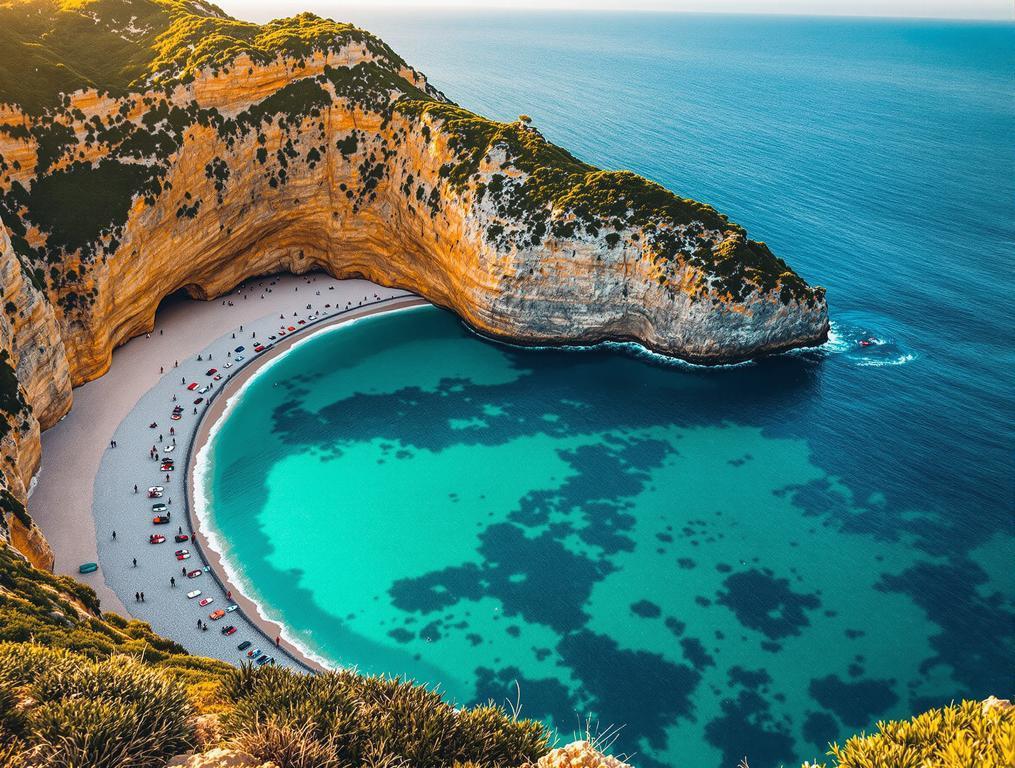The craggy stone stairs disappear beneath my feet as I descend toward what locals simply call “The Beach of Silence.” The name suddenly makes perfect sense. Unlike Spain’s tourist-packed Costa del Sol, only 582 Tripadvisor reviews exist for this horseshoe-shaped paradise tucked along Asturias’ wild northern coast. My footsteps crunch against smooth pebbles as emerald waters lap against Playa del Silencio’s pristine shore, the sound interrupted only by distant seabird calls. This secluded beach, just 10 minutes from Cudillero village, feels impossibly undiscovered.
Spain’s secret 400-meter coastal paradise remains virtually unknown
While millions flock to Barcelona’s packed beaches or Mallorca’s resort-lined shores, Playa del Silencio sits quietly along Spain’s dramatic Asturian coastline. Despite being one of the country’s most photogenic beaches, it remains astonishingly under-visited.
My morning arrival reveals only three other visitors spread across the entire crescent shoreline. No beach bars, no rental umbrellas, no facilities whatsoever interrupt the natural beauty. This deliberate absence of commercialization is precisely what keeps Playa del Silencio pristine.
The turquoise waters against dramatic limestone cliffs create a visual feast that rivals anything on Instagram’s trending page. Yet somehow, 91% of visitors rate it “Excellent” without turning it into an overrun photo destination.
The beach itself stretches 400 meters in length, creating an intimate feeling compared to Spain’s sprawling tourist beaches. Each step reveals a new perspective as the amphitheater-like cliffs frame the Atlantic’s shifting blues.
When local fisherman Manuel passes me on the shore, he nods and offers “¡Buen mar!” – a traditional Asturian greeting meaning “good sea” – before continuing his morning routine, unfazed by visitors. This subtle interaction feels authentic in a way that’s increasingly rare along Spain’s popular coastlines.
Similar Mediterranean hidden gems are increasingly rare, making Playa del Silencio’s continued obscurity all the more remarkable.
Why Playa del Silencio rivals Ireland’s dramatic coastline with summer warmth
The rugged cliffs and untamed atmosphere immediately remind me of Ireland’s Wild Atlantic Way – only with comfortable swimming temperatures and reliable sunshine. Where Ireland’s dramatic western coastline offers moody beauty, Playa del Silencio delivers the same visual drama with Mediterranean summer warmth.
“I’ve traveled all through Spain’s coastlines for decades, but this place remains special because it asks something of you. The effort to reach it filters out those who don’t truly appreciate natural beauty. That’s why it hasn’t changed in thirty years.”
Unlike Spain’s developed Mediterranean coasts, the Asturian shoreline has largely escaped mass tourism. The preserved authenticity rivals that of remote European coastal villages where time seems to move differently.
The surrounding region offers rich cultural experiences beyond the beach. Cudillero’s colorful fishing village sits just minutes away, where traditional Asturian cider flows freely and seafood arrives directly from morning catches.
At low tide, a special secret reveals itself. Walking 200 meters eastward along exposed rocks leads to Ribera del Molin, a hidden beach featuring a small freshwater waterfall cascading directly onto the shore – a natural phenomenon few visitors ever discover.
What the guidebooks won’t tell you
Reach Playa del Silencio via the coastal road between Cudillero and Luarca. The small parking lot accommodates only 30 vehicles and fills completely by 11am in summer months. Arrive before 9:30am to secure a spot.
The steep stone staircase requires appropriate footwear – flip-flops won’t cut it here. Pack everything you need as there are no facilities of any kind on the beach. Unlike other European coves managing summer crowds, Playa del Silencio offers no amenities by design.
Visit during low tide to maximize exploration possibilities, especially if you want to reach the hidden waterfall. Check local tide tables, as high tide can reduce the beach to a narrow strip of pebbles.
While summer offers the warmest swimming conditions, June and September provide the perfect balance between comfortable temperatures and minimal visitors. Weekdays see 70% fewer visitors than weekends, especially before noon.
As I climb back up the stone stairs, casting one last glance at the empty crescent shore below, I’m struck by a rare feeling in modern travel – genuine discovery. My daughter Emma would call this a “treasure beach” – the kind you mark on a special map and keep mostly to yourself. In an age where every destination seems cataloged and hashtagged into oblivion, Playa del Silencio remains what its name promises – a quiet conversation between traveler and nature, largely undisturbed by the outside world.
